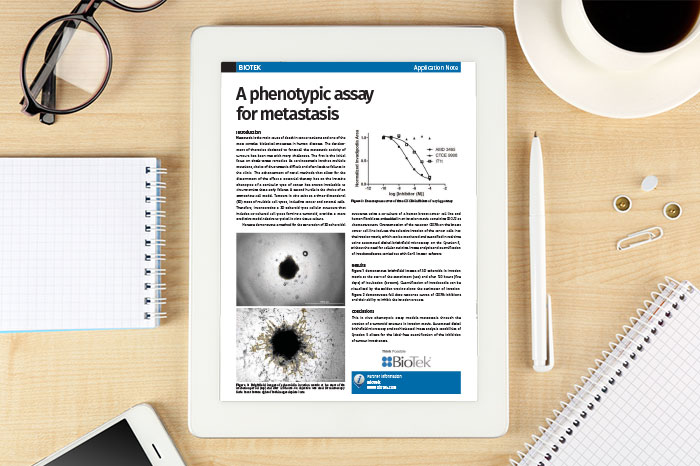Application Note: A phenotypic assay for metastasis
Posted: 8 January 2016 | BioTek Instruments | No comments yet
BioTek demonstrate a method for the generation of 3D spheroidal structures using a co-culture of a human breast cancer cell line and human fibroblasts embedded in an invasion matrix containing CXCL12 as chemoattractant…
Metastasis is the main cause of death in cancer patients and one of the most complex biological processes in human diseases. The development of therapies designed to forestall the metastatic activity of tumours has been met with many challenges. The first is the initial focus on single target remedies. As carcinogenesis involves multiple mutations, choice of drug target is difficult and often leads to failures in the clinic. The advancement of novel methods that allow for the discernment of the effect a potential therapy has on the invasive phenotype of a particular type of cancer has proven invaluable to circumventing these early failures. A second hurdle is the choice of an appropriate cell model. Tumours in vivo exist as a three-dimensional (3D) mass of multiple cell types, including cancer and stromal cells. Therefore, incorporating a 3D spheroid-type cellular structure that includes co-cultured cell types forming a tumoroid, provides a more predictive model relative to typical in vitro tissue culture.
Here we demonstrate a method for the generation of 3D spheroidal structures using a co-culture of a human breast cancer cell line and human fibroblasts embedded in an invasion matrix containing CXCL12 as chemoattractant. Overexpression of the receptor CXCR4 on the breast cancer cell line induces the selective invasion of the cancer cells into the invasion matrix, which can be monitored and quantified in real time using automated digital brightfield microscopy on the Cytation 5, without the need for cellular staining. Image analysis and quantification of invadopodia was carried out with Gen5 Image+ software.
This application note is restricted - login or subscribe free to access


Why subscribe? Join our growing community of thousands of industry professionals and gain access to:
- bi-monthly issues in print and/or digital format
- case studies, whitepapers, webinars and industry-leading content
- breaking news and features
- our extensive online archive of thousands of articles and years of past issues
- ...And it's all free!
Click here to Subscribe today Login here






